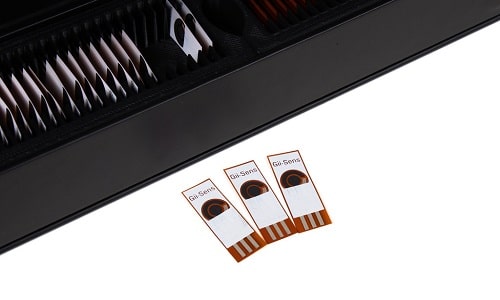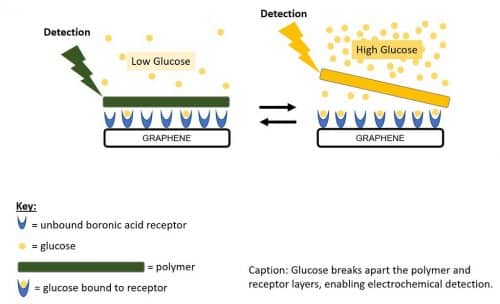The inexpensive glucose measuring sensor more robust than existing blood glucose measuring systems employed in homes and hospitals

Maintaining blood sugar levels is essential for people suffering from diabetes, a chronic condition that affects millions of people globally. To do so, a patient is required to check and monitor their blood sugar levels several times a day. Many current biosensors use enzymes that bind glucose and produce an electric current proportional to the concentration of glucose in the blood sample. However, their reliability compared to clinical laboratory methods is not robust.
Therefore, researchers at the University of Bath working in collaboration with Integrated Graphene, have developed a new sensing technique based on graphene foam that can detect glucose levels in the blood. Instead of being enzyme-based, the new sensor is robust, has a long shelf-life and can detect lower glucose concentrations than current systems. The sensor is also not affected by high temperatures or changes in pH.
Furthermore, it can accurately detect a wide range of glucose concentrations above and below current biosensor ranges, which may be useful in neonatal glucose sensing.
“Many current glucose-sensing methods rely on biological components such as enzymes, meaning they can be sensitive to temperature and pH changes, which may affect accuracy and reliability”, said Simon Wikeley, PhD student in chemistry at the University of Bath. “Our system is chemical-based and therefore is robust and reliable. The graphene foam electrode has a high surface area to interact with the blood sample, while the polymer can act as a molecular sieve, filtering out larger molecules in the blood that could interfere with the glucose sensing.”
In the sensor, the boronic acid (present on the graphene foam surface of the sensor) attaches itself to an electroactive polymer layer that has been added externally. Because glucose is attracted to boronic acid, it binds itself to it, displacing the polymer. Then an electric current proportional to the amount of the displaced polymer gets generated. In this way, the glucose concentration is accurately measured.

“We hope that in the future we might be able to apply our glucose detection method to exciting new technologies, such as wearable or implantable glucose monitoring systems,” said Simon Wikeley. “It could also be adapted to sense other molecules or for use in continuous flow systems.”
Professor Tony James, Royal Society Wolfson Research Merit Award holder at the University of Bath’s Department of Chemistry shares the view. “We are still in the early stages of optimising sensitivity and reproducibility but hope this new technology could be used in a wide range of applications, from medical sensing to food production,” he stated. “This sensor has proven to be reusable, which is the first step towards realising a continuous monitoring system.
“Now that we have proved this technique, it opens up the opportunity to take the underlying applied methodology to a vast range of similar point-of-care diagnostics that could profit from associated benefits such as reduced cost and enhanced shelf-life,” said Dr Marco Caffio, Co-Founder and CSO of Integrated Graphene.
“Furthermore, the identified opportunities for means of enhancing the analytical methodology provides sufficient desirability to enhance the platform even more.”
Read here for more






